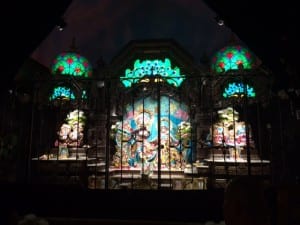Kalichandji Mandir exudes an atmosphere of peace and quiet, a kind of meditative haven surprisingly located a few miles from bustling downtown Dallas in a quaint little neighborhood. I immediately felt relaxed and at peace as soon as I walked into the temple; it sort of transported me to India and the many temples I have visited there. I have been here with my family before about five years ago to see the temple and eat the food, but this visit was special. We had one of the Swamis spend an hour of his time teaching us about the Hare Krishna movement, and it was so interesting learning about this important counterculture movement that defined much of the 60s.
As a practicing traditional Hindu, it was very weird to be at this mandir; it had a sense of familiarity, but almost in a skewed way. I imagine it’s akin to different sects of another religion like Christianity or Islam, but this is the first time I’ve experienced something like this. The followers of ISKCON (International Society of Krishna Consciousness), the organization behind the Hare Krishna movement, only recognize Krishna as a God. Although some mainstream Hindu temples are centered on one deity, many temples have different deities and most Hindus recognize multiple deities or forms of God, even if they’re monotheistic. Also, it was interesting to see that this group of people is proselytizing, because most Hindus are not. On the other hand, many aspects of this experience were very familiar to me. The Aarthi at the end is common, and the placement of deities and the idols were all very similar to other Hindu temples.
The fascinating thing about the Hare Krishna movement is that it brought Hinduism and India into the cultural mainstream during the 60s. Many people of varying ethnicities regularly follow it (and I was pleasantly surprised to see many people of different ethnicities in the mandir when I was there too), and the founder, Bhaktivedanta Swami, or Prabhupad, was very revolutionary in that he spread Hindu teachings around the world (and at a very late age too!).
However, the disadvantage of this is that after Prabhupad passed, not many followers are as familiar with Hindu traditions and how closely it aligns to Indian culture. There was not a very well organized system that would lead the movement after Prabhupad’s passing, and so, many of the teachings have, in my opinion and others’ opinion, been skewed. This was evident when we saw the Swami during our tour too. Although he was clearly passionate about Krishna and the Hare Krishna movement and wanted to pass the teachings on, I personally feel like he may have been unprepared and explained the facts in an incorrect way. I imagine explanations like his may even serve to turn some people away if they do not have previous exposure because of the absurdity of some of the claims. Many people I know, including myself, personally do not believe in many of the claims he was making and they rather focus on the philosophy behind Hinduism. I feel like our tour guide does in fact know a lot about this aspect of Hinduism himself, but he did not focus on it as much. I think he could have focused more on that rather than the complicated mythological stories that require some more time to understand, especially considering his audience in this scenario was very new to Hinduism.
Regardless, the trip to the Kalachandji Mandir was amazing. I learned a lot about a different style of Hinduism, and the food after the tour was amazing. I was really craving some Indian food, and this food prepared by the devotees tasted very good. The dal was some of the best dal I’ve had, and the tamarind tea was delicious. Despite what I said, I would recommend anyone to go to the temple and check it out. It’s a good escape from the hustle and bustle of modern life, and I will definitely be taking my friends there for the temple and the restaurant.


